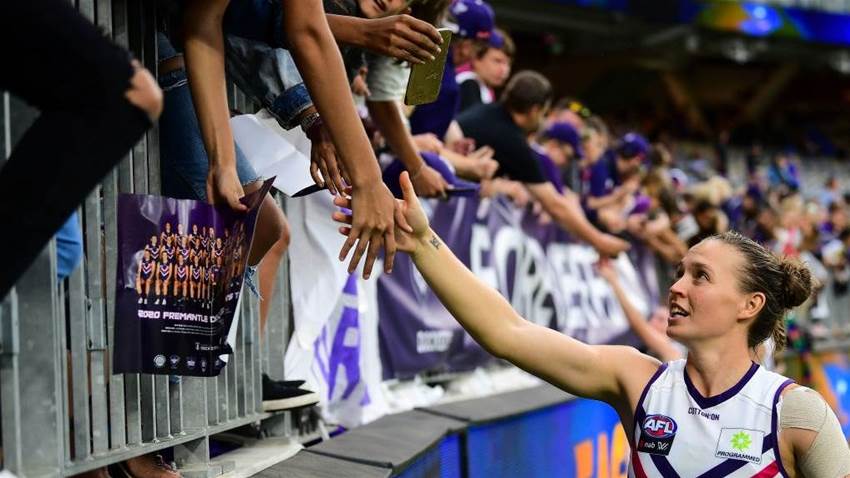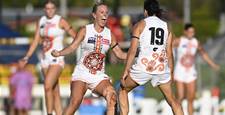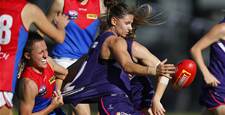Despite an unfortunately short season, there’s no doubt that the AFLW is increasing steadily in popularity, raising the bar for women’s sporting leagues and setting a strong precedent for inclusivity that will hopefully prevail for many years to come.
In 2019, the AFL's revenue increased to a record $794 million due to broadcasting and commercial revenue streams. Funding for the AFLW increased by $6 million in 2020, allowing for the expansion of the competition to 14 teams. We saw player wages as a whole almost double from the 2019 season, 120 additional players were welcomed to the competition, and 23 additional home and away games were added through the new CBA (Collective Bargaining Agreement). Unfortunately, the season was heavily impacted by the coronavirus pandemic and no premiership was awarded, but with participation in women’s football hitting an all-time high we can still see how much women’s footy has grown over the past few years.
The 2020 season started off a bit of rocky with the AFL Women's playing group at a stalemate around the immediate future of the competition due to complications surrounding the CBA for the next three seasons. The first version of the CBA presented to players set out eight home and away rounds in 2020, and nine in 2021 and 2022, with three weeks of finals each year. The players however, wanted a year-on-year build. Thankfully, the AFL Players Association and AFL renegotiated and settled on 10 rounds for the 2022 season, despite many players hoping to reach 13 games in 2021 so that every team can play each other once.
Another important part to the CBA was the player wages, which saw $8.12 million spent in Total Player Payments (TPP), a 21% increase in club TPP from the 2019 season, which again is set to steadily increase per club in the 2021 and 2022 seasons, respectively. The game is continuously growing a bigger following every year, with the womens AFL twitter account gaining over 32,000 followers, building an even bigger presence on social media, sharing more and more AFLW content than ever before. It’s exciting to see a bright future for AFLW players and the community as a whole.
When @NorthAFLW make their first ever NAB #AFLW Preliminary Final 🥳 #AFLWFinals #FootyAtHome
— AFL Women's (@aflwomens) March 21, 2020
🎥: James Teirney pic.twitter.com/q1bvrnguR6
With the addition of the expansion team, crowds continued to grow. This season’s largest crowd gathered for the Western Australian derby in Round 2 as 35,185 people filed into Optus Stadium for the Saturday night rival game between the Dockers and the newly-formed Eagles. Although Fremantle ran out as comfortable winners against new expansion side, it was a historic day for football in the west and highlighted the importance of the new teams in the league. It’s the second biggest crowd ever recorded for a home-and-away game after a record 41,975 were at the same ground back in 2018 when it first opened its doors for Fremantle’s clash with Collingwood.
The 2019 grand final between Adelaide and Carlton still holds the highest attendance with a whopping 53,034 fans watched Adelaide win their second premiership. A further 409,000 viewers watched from their homes around the country, a 71% increase from the 2018 grand final.
On this day in 2019 - the number 53,034 was etched into our memories as @CrowsAFLW took home the 2019 NAB AFL Women's Premiership in front of the biggest #AFLW crowd we have ever seen 🏆 #GenW pic.twitter.com/avbtMm1jSg
— AFL Women's (@aflwomens) March 31, 2020
Despite the home and away season being cut short by two weeks, there was still seven more games played due to the addition of the four expansion clubs. The average crowd at games grew by 1,500 people this year, and the audience for AFLW broadcasts grew by 19%. This means that there were more people watching more games of footy this year, both at the game and watching from home, which is set to increase again in 2021.
This high-profile success of AFLW and the rise of other professional women’s sport leagues have helped drive overall visibility for women in sport with more females playing footy than ever before. Since 2013, female football participation has boomed from 195,000 to 530,166 in 2019, reflecting 32 per cent of all Australian football participation last year. That figure is now estimated to be over 600,000 and is expected to grow even more with teams, games, crowds and broadcast ratings rising to new heights in 2020.
The NAB AFL Women's competition has played a key role in contributing to this outstanding increase in football participation and has come a long way since the 2017 inaugural season, ensuring a new generation of footballers. Finally, young female footballers are seeing a pathway for themselves giving them the courage and support to continue to play the great Aussie game.
PRACTICE MAKES PERFECT!
— AFL Women's (@aflwomens) March 27, 2020
Now is the time to perfect the bounce - take it from this little #GenW super🌟
🎥: Bobby McCallum pic.twitter.com/7nbROiL689
Related Articles

Grace Kim locked in for Australian WPGA Championship

Aussie clubs backing Women In Golf Charter reaches 100













